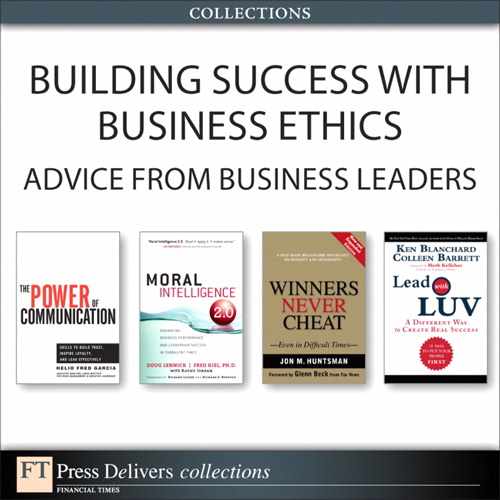Contents
The Power of Communication: Skills to Build Trust, Inspire Loyalty, and Lead Effectively
Introduction: Leadership, Discipline, and Effective Communication
PART I: LEADERSHIP AND COMMUNICATION: CONNECTING WITH AUDIENCES
The Nature of Effective Leadership Communication
The Audience Has Its Own Ideas
The Struggle to Win Hearts and Minds
Recap: Best Practices from This Chapter
Lessons for Leaders and Communicators
What Bill Gates Said/What the Audience Heard
Restraining the Imperious Executive
Recap: Best Practices from This Chapter
Lessons for Leaders and Communicators
Hurricane Katrina, New Orleans, and the U.S. Government
Overnight, Sunday to Monday: Katrina Strikes
Monday: New Orleans Under Water
Wednesday: The Situation Is Dire; Government Seems Not to Get It
Friday: The President Steps Up But Misfires
Monday, September 5: Self-Inflicted Harm
Wednesday: President Bush and Michael Brown as Laughingstocks
Friday: FEMA Director Brown Is Out
Trust, Consequences, and the Say-Do Gap
Recap: Best Practices from This Chapter
Lessons for Leaders and Communicators
4 Speed, Focus, and the First Mover Advantage
The Marines Act on the Fallujah Shooting
Abu Ghraib and Loss of the First Mover Advantage
The First Mover Advantage and Celebrity Scandal
Operationalizing the First Mover Advantage
Recap: Best Practices from This Chapter
Lessons for Leaders and Communicators
5 Initiative, Maneuver, and Disproportionality
Recap: Best Practices from This Chapter
Lessons for Leaders and Communicators
PART II: STRATEGY AND COMMUNICATION: PLANNING AND EXECUTION
6 Goals, Strategies, and Tactics: Preparing and Planning
Planning Isn’t Looking at a Calendar; It’s Looking at a Chessboard
Understanding Strategy: Thinking Clearly on Three Levels
Template for Planning: For Being Strategic in Leadership Communication
Recap: Best Practices from This Chapter
Lessons for Leaders and Communicators
PART III: BUILDING SKILLS: GETTING GOOD AT COMMUNICATING WELL
7 Performance: The Physicality of Audience Engagement
Commitment to Self-Development
Physicality: Let Me Hear Your Body Talk
Recap: Best Practices from This Chapter
Lessons for Leaders and Communicators
8 Content: Word Choice, Framing, and Meaning
Metaphor and the Management of Meaning
Recap: Best Practices from This Chapter
Lessons for Leaders and Communicators
9 Audiences: Attention, Retention, and How Hearts and Minds Work
The Amygdala and Audience Engagement
Adapting to the Amygdala: Five Strategies for Audience Engagement
The Primacy of the Visual: The Eyes Have It
Recap: Best Practices from This Chapter
Lessons for Leaders and Communicators
10 Putting It All Together: Becoming a Habitually Strategic Communicator
Communication Is a Leadership Discipline
Nine Principles of Effective Leadership Communication
Appendix Warfighting Principles for Leadership Communication
Winners Never Cheat Even In Difficult Times
Introduction Good Times, Bad Times
Circumstances may change but your values shouldn’t.
Chapter One Lessons from the Sandbox
Everything we need for today’s marketplace we learned as kids.
Chapter Two Check Your Moral Compass
We know darn well what is right and wrong.
Chapter Three Play by the Rules
Compete fiercely and fairly—but no cutting in line.
Chapter Four Setting the Example
Risk, responsibility, reliability—the three Rs of leadership.
It’s high time to corral the corporate lawyers.
Chapter Six Why We Cross the Line
There are many temptations, but reminders help.
Chapter Seven Pick Advisors Wisely
Surround yourself with associates who have the courage to say no.
Chapter Eight Get Mad, Not Even
Revenge is unhealthy and unproductive. Learn to move on.
Chapter Nine Graciousness Is Next to Godliness
Treat competitors, colleagues, employees, and customers with respect.
Chapter Ten Your Name Is on the Door
Operate businesses and organizations as if they’re family owned.
Chapter Eleven The Obligation to Give Back
Nobody is completely self-made; return the favors and good fortune.
Chapter Twelve The Bottom Line
Acceptable values are child’s play, not rocket science.
Lead with LUV: A Different Way to Create Real Success
Servant Leadership is Love in Action
Understanding Servant Leadership
Making Unions Your Business Partners
What Makes Servant Leadership Work?
Differences Between Self-Serving and Servant Leaders
About the Leading at a Higher Level Series
Moral Intelligence 2.0: Enhancing Business Performance and Leadership Success in Turbulent Times
Foreword to Previous Edition by Richard E. Boyatzis
What Does Moral Leadership Look Like?
Why We’re Good and Why We’re Bad
The Neuroscience of Moral Decision Making
Can We Actually Change Our Brain?
4 Staying True to YourMoral Compass
PART TWO • DEVELOPING MORAL SKILLS
Acting Consistently with Principles, Values, and Beliefs
Taking Responsibility for Personal Choices
Admitting Mistakes and Failures
Embracing Responsibility for Serving Others
Letting Go of Your Own Mistakes
Letting Go of Others’ Mistakes
11 Leading Large Organizations
Is There Such a Thing as a Morally Intelligent Organization?
The Morally Intelligent Organization—An Aerial View
The Principles That Matter Most
Cultivating Organizational Integrity
The Compassionate Organization
Reinforcing Values Starts at the Top
Values and the Global Organization
12 Moral Intelligence for the Entrepreneur
Moral Values in Small Organizations
Last Words About Business Start-Ups
Epilogue Becoming a Global Moral Leader
A Strengthening Your Moral Skills
The Right Frame of Mind for Completing the MCI
Scoring and Interpreting Your MCI
Prioritizing Your Moral Development Efforts
Putting Your Moral Development Plan into Practice
Reward Yourself for Positive Change
Surround Yourself with Positive People
B Moral Competency Inventory (MCI)
What Your Total MCI Score Means
D Interpreting Your MCI Scores
Total MCI Score (Alignment Score)
